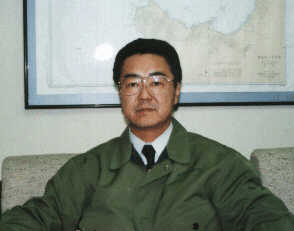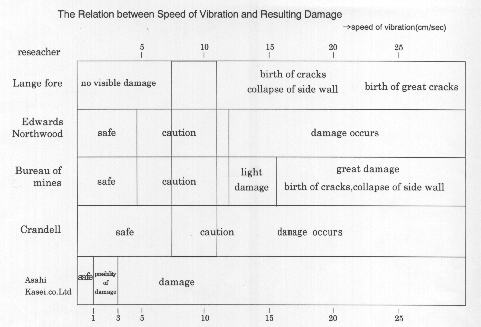

ü@The following is a summary of events following the collapse
of the toyohama tunnel, which occurred February 10,1996 at 8:10
AM. At 9:15 AM. at the request of Hokkaido Development Agency
Otaru Construction Division ,we rushed to the site of the accident
and entered discussions. Hokkaido Development Agency Otaru Construction
Division and its local supporting company Fukutsu-gumi joined
with us in considering the best course of action, the result of
which we came to the decision at around 5:30 PM to use explosives
to make it possible for heavy machinery to deal with the situation.
In my initial timetable, setting up a platform from which to drill
holes would take 12 hours, drilling and packing the holes 12 hours,
and other preparations 12 hours.
[Initial tentative schedule]
the 10th 18:00-6:00ü@
requisition of machinery, explosives, and personnel(to handle heavy machinery and explosives)
the 11th 6:00-18:00ü@
bringing in snow to serve as platform and pilot road
the 11th 18:00-24:00ü@
drilling holes for explosives
(8 columnsü~5 rows=40 holes hole length 8-5m)
the 12th 0:00-6:00ü@
charge-690kg
Having received approval for the above plan, I was on my way
back to sapporo for the purpose of requisitions when I received
an urgent summons from Yasushi,Takamatsu, the chief of the headquarters,
who requested that, human lives being at stake , the time of the
blasting be moved up to the next morning. upon further consideration,
calculating vibration value caused by the planned amount of explosives.
it was estimated that this amount would affect the bus and car
buried under the rubble. For these reasons it was decided that
a total of only 250kg of explosives be used,to be detonated in
stages with 50kg detonated at one time, the blasting to be completed
within the indicated 12 hour period. Despite some delays, the
drilling of 22 holes was completed on the 11th at 8:30 AM. We
waited for the order to pack the holes;which was given at 12:30,and
this was completed at 15:00 after which we waited for the order
to do the blasting(time of the blast 16:30).Because the fallen
boulder was leaning against the mountain, it was deemed impossible
to topple over. There was a suggestion that if the base of the
rock could be shifted, the rock would slide bottom first out to
the sea, but the actual result was that the boulder became lower,
resting in the same place.
In this complicated type of center cutting blasting, changing
the number of explosive charges doesn't have such a great effect;
rather ,it is the fractured area that is decisive. It was out
of consideration for the vibration of the accident site that we
didn't place charges over a wider area.
The explosions themselves were successfully carried out, but the
boulder didn't slide. Reflecting upon this, I had regrets that
I didn't insist upon my initial plan. It is true that, having
been told that lives were at stake, the initial planned amount
of explosives was too large. and I understand the headquarters
chief Takamatsu's directive to proceed quickly for the sake of
the families of the victims, but it remains a fact that the blasting
was different from that which I conceived.
üťEstimation of blast vibration
Estimation of blast vibration in determining the amount of
explosives to use, the effect of blast vibraation on the victims
inside the tunnel was the prime consideration.
the amount of explosives in one simultaneous blast was calculated
so as not to further crush the bus and car in the tunnel.
the effect of blast vibration on surroundings as determined by
various sources is given in the following chart .

From the following it was deemed necessary to keep vibration
with in the range indicated by the diagonal lines
Formula for estimating detonation vibration
V=KąW2/3ąD-2
Professor Ito,Kyoto University
V=displacement speed(cm/sec)
W=amount of mass shooting explosive(kg)
D=distance from explosion(m)=20m
K=constant dynamite;300
V=KąW2/3ąD-2
=300ü~502/3ü~20-2
=10.179cm/sec
üťAppraisal of Blasting Operations
1st blasting Feb.11 16:25
ü@The limitation of the fractured section to 250çu was based upon
calculation of vibration arising from the amount of explosives
to be detonated simultaneously, and was unavoidable in my consideration.
Because this was not an operation to restore the accident site
to its previous condition, but rather a life-rescue operation
the most reliable blasting procedure could not be used.
With the usual kind of rock the probability that the boulder would
fall would be 100%, but in this case the boulder was an especially
soft type of volcanic agglomerate and the chance of success was
considered to be very low. It was fully anticipated that the boulder
would not back brake, but rather become putty-like with the explosion,
and so the holes were filled to 80% capacity (60%-70% is usual
at our company).
The line of least resistance was set at 2m,and care was taken
not to drill through to the other side. Of the 26 charges 4 were
test exploring hole. It was intended that with this one detonation
the rock would fall and the heavy machinery could begin operations,
and speaking to the families of the victims to this effect the
general headquarters staff continued to try their best to get
agreement to the blasting. Because of the time it took to get
this agreement, the packing of the holes was started 3 hours after
the holes were drilled. During this period the holes began to
crumble, which made the packing of explosives difficult. In fact,
the explosives could not be packed completely as planned. Approaching
the face of the boulder after the blast, with everyone's sighs
of disappointment at our backs, the feeling of remorse at having
betrayed the deepest wishes of the families and the expectations
of headquarters, together with the thought "Now our company
is done for" rushed upon me.
2nd blasting Feb. 12 16:00
ü@failure to bring down the rock-the call to headquarters-explanation
of the reason for the failure-apology to the concerned parties.
The response of headquarters to the situation after the first
blasting was swift, and after considering various methods for
3 hours, the decision to do another detonation was relayed to
me. However, some of the families had returned to their homes,
and among them some could not be reached. We were directed not
to do any preparations for a new blasting , such as drilling holes
until the meeting the next morning of all the parties where they
would give agreement to the blasting. That night progress was
made in a new road from the side of the tunnel close to Yoichi,
using a concrete breaker to break up rolling stones. The next
morning, When the bus carrying the families to the site of the
meeting passed by the scene of the accident, someone shouted from
the bus, "Yuko, you gotta hang in there!" Hearing this.
I shook off my dark thoughts of the previous day and determined
to do or die in the forthcoming work. Looking back, I am somewhat
shocked at what I did, but the fact remains that I put some impossible
demands on my staff. At 7:00 we were directed to begin work and
started drilling holes, and despite a delay due to the danger
of rock falls the drilling was completed at 12:00. The previous
blasting had shifted the boulder's center of gravity toward the
sea, so the there was a suggestion that with a V-cut alignment
of charges the rock could be toppled. However, while packing the
holes the rock again shifted toward the mountain, making it hard
to decide whether a V-cut was the best course of action. Such
was the situation that we couldn't even predict what the result
of the explosion turned out be. The most important charges, the
two rows close to the mountain, were dissipated into two vertical
cracks, and the boulder did not fall. Looking from the side of
the tunnel closest to Furubira, there now appeared the sculptured
face of a demon in hell. It dawned on me that we were facing an
unseen challenge, and I made up my mind to stick with it to the
end wherever it might lead. I made the request to headquarters
not just for one more blasting, but to continue a series of blasting
if necessary. I came to the conclusion that the boulder had to
be completely pulverized.
Convinced that no one could do any better than we could, from
the third explosion on I made no apologies.
3rd blasting Feb. 13 12:30
ü@During the night we built the pilot road, at 3:00 AM we began drilling holes, and packing the holes and tie was completed at 10:30. Having had no expectation that we would be successful with the second blasting, we had immediately begun preparation for the next blasting. Thinking that this time there would be an 8m drop of the boulder, I had received approval to continue blasting, intending to complete work with the next one. However, the energy of the explosion was once again absorbed into cracks and the result was not as anticipated. Small rocks were shed along the boulder's sides and the boulder became thinner, but its height was still 20m. It was thus a possibility that a 4th blasting would not complete the operation. Unfortunately one of the cracks resulted in an overhang on the Yoichi side, and the road there was rendered unusable.
4th blasting Feb. 14 11:00
ü@We urgently made preparations for a road from the Furubira side of tunnel, and at this time 8 detonation experts came to inspect, requesting a discussion of blasting methods. Because the road was still under construction we had some spare time, and we entered discussions. The meeting was from 20:00 to 22:00. The previous blasting was appraised, and the 4th was planned out. Out of the need to be consistent with headquarters' response to press reports of our blasting failures, we adopted the plan of the experts, there being at any rate no great difference from our pattern of action. they called for 25 charges with a total of 350kg of explosives, while we had planned 15 charges with 250kg, the experts in my impression placing stress solely on success of the blasting, but we decided we had no time to debate and instructed the drilling staff to follow the experts' plan. A crack developed as the holes were being drilled, and operations were halted with 16 holes finished. 4 hours passed without approval to resume work, and entirely on my own I made the decision to do the blasting with only the holes that had been drilled. This was because, in our judgment, 12 holes were sufficient. The boulder had thinned to 7-800m3, and the part to be planted with explosives was only 6-8m. The result was another lowering of the boulder, as expected, and the remaining rock lost a place to settle and fell down the slope, thus ending blasting operations.
Overview
ü@In overview, only one point is of importance-the failure to
employ a blasting pattern that would remove the boulder with one
blast. This was however unavoidable because of the overriding
precedence given to the rescue of lives. The unexpected results
of the 2nd and 3rd detonations were due to vertical hair cracks
which couldn't have been detected save through boring samples.
Looking back, I can say we did close to the best we could have
done, fighting with time during those 4 long days.
The ex-headquarters chief Takamatsu's and technical manager Takese's
swift decisiveness was regrettably not reported in the press,
but upon reflection they did remarkable work.
I wish to thank the Terakado company (handling of explosives and
transport) for listening to my unreasonable demands late into
the night,
the Development Agency, the Shiribeshi branch office, the police,
and bureau of standards for co-operation for beyond their legal
obligations, and the fire department for co-operation in supplying
water for the snow pilot road.